
Termites are a group of detritophagous eusocial insects which consume a variety of decaying plant material, generally in the form of wood, leaf litter, and soil humus. They are distinguished by their moniliform antennae and the soft-bodied and often unpigmented worker caste for which they have been commonly termed "white ants"; however, they are not ants, to which they are only distantly related. About 2,972 extant species are currently described, 2,105 of which are members of the family Termitidae.

Blattodea is an order of insects that contains cockroaches and termites. Formerly, termites were considered a separate order, Isoptera, but genetic and molecular evidence suggests they evolved from within the cockroach lineage, cladistically making them cockroaches as well. The Blattodea and the mantis are now all considered part of the superorder Dictyoptera. Blattodea includes approximately 4,400 species of cockroach in almost 500 genera, and about 3,000 species of termite in around 300 genera.
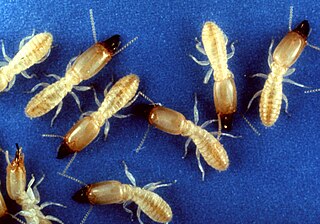
Reticulitermes flavipes, the eastern subterranean termite, is the most common termite found in North America. These termites are the most economically important wood destroying insects in the United States and are classified as pests. They feed on cellulose material such as the structural wood in buildings, wooden fixtures, paper, books, and cotton. A mature colony can range from 20,000 workers to as high as 5 million workers and the primary queen of the colony lays 5,000 to 10,000 eggs per year to add to this total.

Tandem running is a pair movement coordination observed in ants and termites.

Coptotermes gestroi, commonly known as the Asian subterranean termite is a small species of termite that lives underground. Both this species and the Formosan subterranean termite are destructive pests native to Asia, but have spread to other parts of the world including the United States. In Asia, this species is known as the Philippine milk termite.
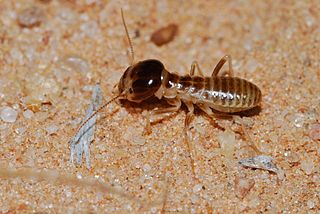
The Hodotermitidae are a basal Old World family of termites known as the harvester termites. They are distinguished by the serrated inner edge of their mandibles, and their functional compound eyes which are present in all castes. They forage for grass at night and during daylight hours, and the pigmented workers are often observed outside the nest. Their range includes the deserts and savannas of Africa, the Middle East, and Southwest Asia. Their English name refers to their habit of collecting grass, which is not unique to the family however.

Reticulitermes is a termite genus in the family Rhinotermitidae. They are found in most temperate regions on Earth including much of Asia and the Middle East, Western Europe, and all of North America.

Incisitermes minor is a species of termite in the family Kalotermitidae known commonly as the western drywood termite. It is native to western North America, including the western United States and northern Mexico. It has been found in many other parts of the United States, all the way to the East Coast. It has been reported from Toronto. It has been introduced to Hawaii. It has been noted in China and it is not uncommon in Japan. This is an economically important pest of wooden structures, including houses. In California and Arizona alone its economic impact is estimated to be about $250 million per year.
Coptotermes frenchi, the Australian subterranean termite, is a species of termite in the family Rhinotermitidae. Termites are social insects and C. frenchi usually builds its communal nest in the root crown of a tree. From this, a network of galleries extends through the nearby soil, enabling the workers to forage in the surrounding area without emerging on the surface of the ground.

Coptotermes acinaciformis is a species of subterranean termite in the family Rhinotermitidae native to Australia. Termites are social insects and build a communal nest. In the case of C. acinaciformis, this is either in the root crown of a tree or underground. From this, a network of galleries extends through the nearby soil, enabling the workers to forage in the surrounding area without emerging on the surface of the ground. This termite can cause substantial damage to trees and the wooden parts of buildings.

Cryptotermes brevis is a species of termite in the family Kalotermitidae, commonly known as the West Indian drywood termite or the powderpost termite. It is able to live completely inside timber structures or articles made of wood such as furniture without any outside source of water. It is frequently introduced into new locations inadvertently, and causes damage to the structural timbers of buildings and to wooden objects such as furniture.
The Indo-Malaysian drywood termite,, is a species of dry wood termite of the genus Cryptotermes. It is found in Philippines, Australia, Papua New Guinea, Hawaii, and introduced to Sri Lanka. It is the smallest termite species in Australia, with 2.5 – 3.7mm in soldiers.
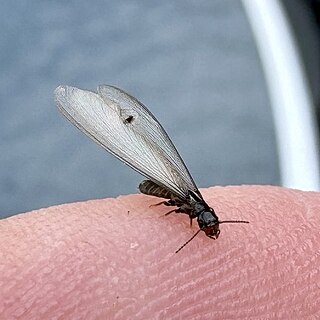
Reticulitermes hesperus, the western subterranean termite, is a species of termite in the family Rhinotermitidae. It is found in Central America and North America. R. hesperus is native to the coast between British Columbia and Southern California. Like other subterranean termites, they live underground, where they have elaborate eusocial societies composed of a queen, workers, and soldiers, as well as a rotating case of sexually reproductive adults and their larval and immature offspring. The reproductive adults are the only ones with functional wings. The reproductive adults will swarm on warm days in spring and fall, particularly after a rain event, looking for mating partners. These termites prefer moist living environments and prefer to consume wood that has already been partially decayed by saprotrophic fungus.
Marginitermes hubbardi, commonly known as the light western drywood termite, is a species of termite in the family Kalotermitidae. It is found in Central America and desert regions of southwestern North America.
Prorhinotermes simplex, the Cuban subterranean termite, is a species of lower termite in the genus Prorhinotermes. It is found in Colombia. Like others in its genus, it is a single-site nesting termite that moves to a new food source when theirs is gone, and it lacks a true worker caste.
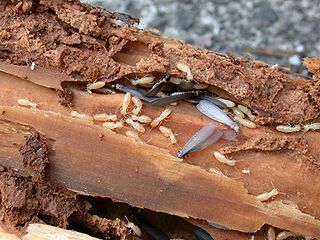
Reticulitermes speratus, the Japanese termite, is a species of subterranean termite found in Japan, North Korea, and South Korea. It eats decayed wood. It is adapted to withstand the cold temperatures of the temperate regions it inhabits.
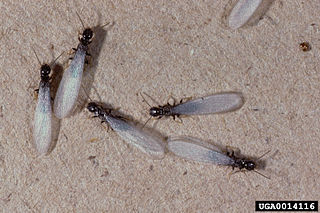
Reticulitermes virginicus is a species of subterranean termite native to North America, found often in the southern United States. It was described in 1907.
Amitermes floridensis, commonly known as the Florida darkwinged subterranean termite, is a species of eusocial insect in the family Termitidae. It feeds on rotting wood, reached by a network of tunnels. It is endemic to west central Florida and was first described in 1989.

Reticulitermes tibialis, the arid-land subterranean termite, is a species of termite in the family Rhinotermitidae. It is found in the United States, mostly in the western half, occurring in deserts, prairies and other dry locations.
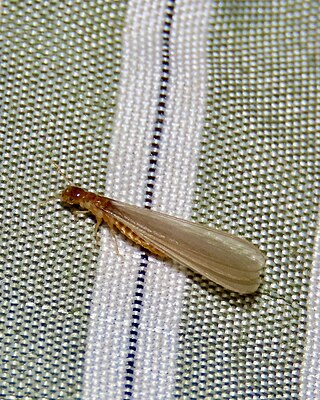
Heterotermes aureus, commonly known as the desert subterranean termite, is a species of termite in the family Rhinotermitidae. It is native to the deserts of North America where the colony has an underground nest.


















